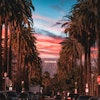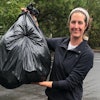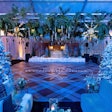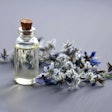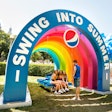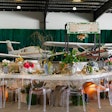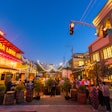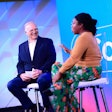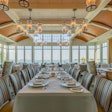The Horticultural Society of New York's annual Flowers & Design fund-raiser brought together 35 of the top event and floral designers in the city (and beyond) and filled Gotham Hall with 33 creative tables that ranged from elegant and classic to just plain curious. The benefit typically presents a variety of floral and tabletop inspirations—much like Diffa's Dining by Design showcase, or perhaps more like the New York Botanical Garden's Orchid Dinner—and this year's version presented a mix of traditional and modern components.
Maureen Ferry, the organization's director of special events, oversaw the event and worked with design chair Chris Giftos, the former events chief of the Metropolitan Museum of Art, who supervised the designs. Last year, the society pushed designers to be less conventional—an effort to tie an avant-garde theme as an homage to honorees Christo and Jeanne-Claude. "This year [there] was more of a traditional theme. We are moving to a new location in June and are revitalizing our programs and entering a new age," Ferry told us.
The official theme was "Celebrating the Renaissance, Designing the New Golden Age." The weighty dictate appeared on invitations with a still life by 17th-century Dutch painter Jan Davidz Heem: a banquet scene laden with piles of fruit. Many designs leaned toward the past, using a Renaissance feel, and most of the looks were decidedly more conservative. This overall traditional air was also influenced by the evening's honoree, interior designer Bunny Williams. After all, as Williams's corporate Web site notes: "Schooled in the classics, restraint and appropriateness are hallmarks of Bunny's style." (Designer DeJuan Stroud placed small rabbit figurines on his table as an homage.)
A few designers worked with scale, building monumental structures or miniature environments. Renny & Reed positioned four tall columns topped with classical urns and cherry blossom branches to define the table. Nearby, Lewis Miller of LMD Floral Events Interiors created a lovely garden setting, using tall topiary obelisks to hem in his predominantly gold and off-white table. Remco van Vliet of Van Vliet & Trap used the same convention of defining the four points around the dining table, and positioned large white, modern pedestals capped with white dogwood blossom branches. Two more large pieces were Antony Todd's lavish tent and the unusual work by Susan Edgar of Flowers, Sticks, and Stones.
Edgar's piece deserved investigation—it was actually made up of three round tables of different sizes grouped together, like cogs or wheels. A towering, multistoried copper structure rose from one table, with shelves of votives and tiny pots of marigolds. In fact, marigolds were everywhere at the three tables, on tabletops and in some cases surrounding the bases of tables.
Harking back to the invitation, an abundance of fruit spilled forth from many tables. Miller featured fresh and gilded fruits; Castle & Pierpont filled a transparent trough around their large urn centerpiece with green apples. Antony Todd had dried fruits studded with colored Swarovski crystals, and at Van Vliet & Trap's table fruits were painted metallic white.
Not that anyone asked, but we were thinking: While the neoclassical look of the venue (and Cipriani 42nd Street—the site of the past three benefits) may have worked into the literal theme, we'd love to see this floral showcase at a raw space or an atrium with natural light, like the one at 590 Madison Avenue, which was used in 2002.
—Mark Mavrigian
Photos: Jeff Thomas/Image Capture
Related Stories
Designers Go Avant Garde for Horticultural Benefit
Designers Branch Out for Horticultural Gala
Diffa Showcases New Design Ideas in New Venue
Vivid Designer Tables Fill Orchid Dinner
Maureen Ferry, the organization's director of special events, oversaw the event and worked with design chair Chris Giftos, the former events chief of the Metropolitan Museum of Art, who supervised the designs. Last year, the society pushed designers to be less conventional—an effort to tie an avant-garde theme as an homage to honorees Christo and Jeanne-Claude. "This year [there] was more of a traditional theme. We are moving to a new location in June and are revitalizing our programs and entering a new age," Ferry told us.
The official theme was "Celebrating the Renaissance, Designing the New Golden Age." The weighty dictate appeared on invitations with a still life by 17th-century Dutch painter Jan Davidz Heem: a banquet scene laden with piles of fruit. Many designs leaned toward the past, using a Renaissance feel, and most of the looks were decidedly more conservative. This overall traditional air was also influenced by the evening's honoree, interior designer Bunny Williams. After all, as Williams's corporate Web site notes: "Schooled in the classics, restraint and appropriateness are hallmarks of Bunny's style." (Designer DeJuan Stroud placed small rabbit figurines on his table as an homage.)
A few designers worked with scale, building monumental structures or miniature environments. Renny & Reed positioned four tall columns topped with classical urns and cherry blossom branches to define the table. Nearby, Lewis Miller of LMD Floral Events Interiors created a lovely garden setting, using tall topiary obelisks to hem in his predominantly gold and off-white table. Remco van Vliet of Van Vliet & Trap used the same convention of defining the four points around the dining table, and positioned large white, modern pedestals capped with white dogwood blossom branches. Two more large pieces were Antony Todd's lavish tent and the unusual work by Susan Edgar of Flowers, Sticks, and Stones.
Edgar's piece deserved investigation—it was actually made up of three round tables of different sizes grouped together, like cogs or wheels. A towering, multistoried copper structure rose from one table, with shelves of votives and tiny pots of marigolds. In fact, marigolds were everywhere at the three tables, on tabletops and in some cases surrounding the bases of tables.
Harking back to the invitation, an abundance of fruit spilled forth from many tables. Miller featured fresh and gilded fruits; Castle & Pierpont filled a transparent trough around their large urn centerpiece with green apples. Antony Todd had dried fruits studded with colored Swarovski crystals, and at Van Vliet & Trap's table fruits were painted metallic white.
Not that anyone asked, but we were thinking: While the neoclassical look of the venue (and Cipriani 42nd Street—the site of the past three benefits) may have worked into the literal theme, we'd love to see this floral showcase at a raw space or an atrium with natural light, like the one at 590 Madison Avenue, which was used in 2002.
—Mark Mavrigian
Photos: Jeff Thomas/Image Capture
Related Stories
Designers Go Avant Garde for Horticultural Benefit
Designers Branch Out for Horticultural Gala
Diffa Showcases New Design Ideas in New Venue
Vivid Designer Tables Fill Orchid Dinner
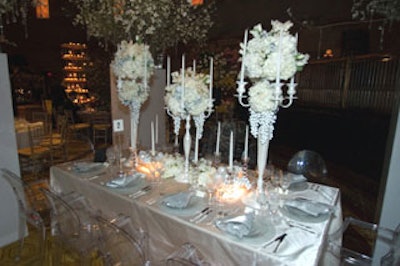
Van Vliet & Trap's table was hemmed in by four massive white pedestals topped with displays of white dogwood blossom branches and strands of sparkling crystals. The look mixed modern and Renaissance touches and included candelabra painted in metallic white, as well as accents of clear modern glass objects and metallic white fruit.
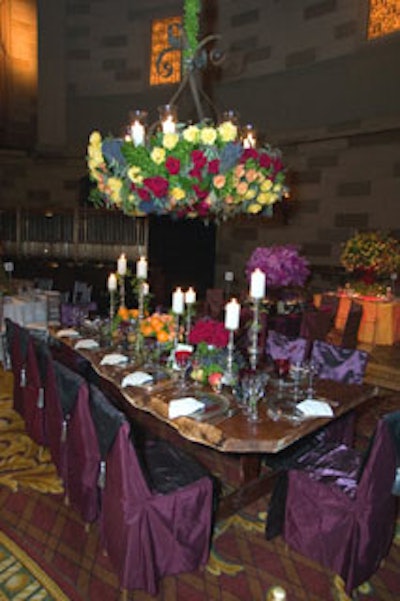
DeJuan Stroud took inspiration from the event's Renaissance-style invitation. Stroud and his team brought in a mango wood banquet table and decked it with silver candlesticks, overflowing fruit, and bowls of dried lavender. Sprigs of lavender were also set under clear glass chargers. Hanging overhead was an enormous wreath chandelier made with yellow, red, and orange roses: eucalyptus; and more lavender.
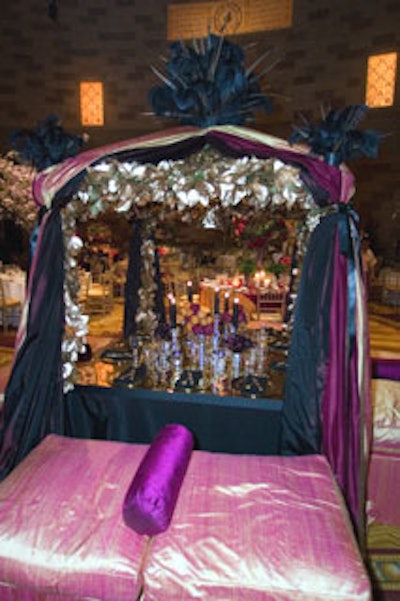
Antony Todd created a regal campaign tent setting, mixing classic and modern elements. Black-burgundy taffeta and dark plum and tangerine dupioni silks covered the tent and accompanying lounge seating. Pheasant feathers adorned the top and corners of the structure.
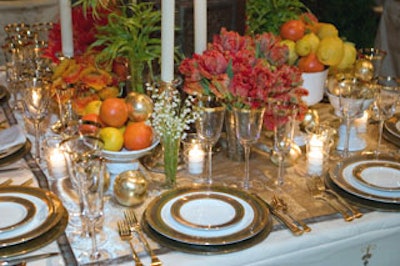
Lewis Miller of LMD Floral Events Interiors created an elegant garden setting. Bordered on four corners by monumental topiary obelisks, the designer's tabletop had a gold and white look with bursts of color in the form of flowers and fruit (with gilded fruit added into the mix).
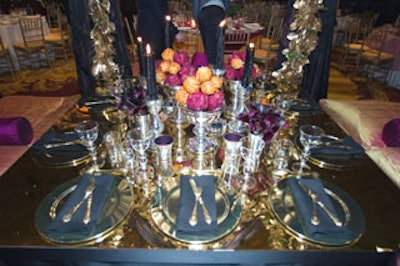
Todd topped the table with a golden mirrored surface and a shimmering concoction of gold and silver flatware, candlesticks, votives, and vases. Colored Swarovski crystals studded dried pomegranates and oranges.
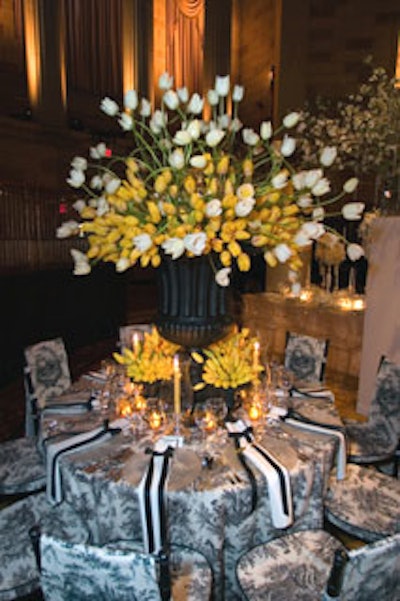
David Beahm worked in a traditional mode-aided by the use of pastoral toile fabrics on the table and chairs, and classical black urns bursting with white and yellow tulips.

Susan Edgar's tabletop had a myriad of objects for guests to investigate. Marigolds were used throughout-from a patch of flowers underneath one the designer's three tables, to little pots that dotted the entire dining area. The colors of marigolds-yellow and orange-extended from linens to the stemware.
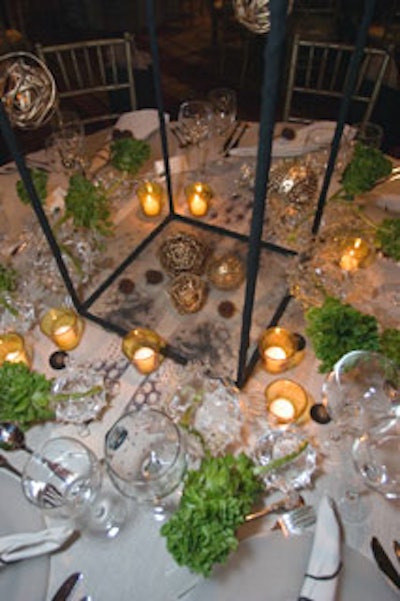
Gotham Gardens' striking table could have been a part of last year's avant-garde benefit, but plenty of golden objects and detailed drawings on the table covering made reference to the Renaissance and Golden Age theme.
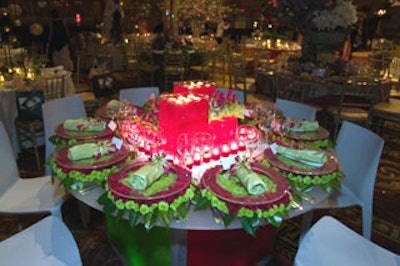
Elizabeth Ryan Floral Design took a modern approach, with two tall rectangular containers filled with red gel and topped with tea lights and complemented by lower, similarly filled containers that held gloriosa lily blossoms and green cymbidium orchids. Clear chargers sat upon rings of red carnations and kermit mums, and the rolled chartreuse napkins were adorned with more lily blossoms.
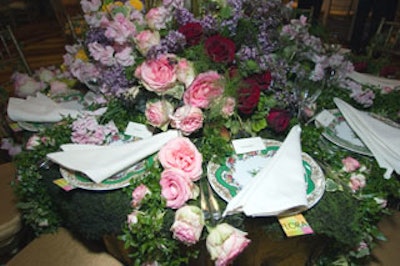
A multitude of roses, lilacs, and vines spilled from the center of the table designed by Flora New York. Flowers, vines, and leaves ran down the sides between each place setting.

